Lessons & Units
A database
of lessons and units searchable by content and cultural standards,
cultural region and grade level. More units will be available soon.
You can use Acrobat Reader to look at the PDF version of the Cover
Sheet
for the Units and Self-Assessment
for Cultural Standards in Practice.
MOOSE
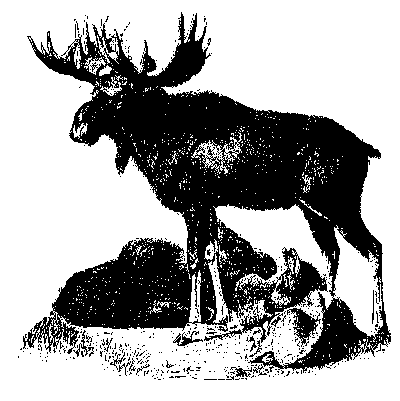
A Cultural Mini-unit
Moose in Interior Alaska
|
Author:
|
Iditarod Area School District Donna
Miller MacAlpine
|
|
Grade level:
|
K-6
|
|
Context:
|
2 weeks, preferably during hunting
season
|
|
Region:
|
Interior Athabascan
|
|
Goals:
|
1. To familiarize students with basic
characteristics of alces alces, the moose, our largest
deer
2. To familiarize students with the range
and habitat of moose.
3. To have students become aware of the
importance of moose to both the traditional and modern
Alaskan way of life.
4. To increase oral and written language
skills in English and in the local Native
language.
5. To develop basic science and math
skills within the local cultural setting.
|
The selected Alaska Content Standards for Science,
Math and the Cultural Standards for Students which are addressed by
this unit are identified and the skills and knowledge which are
expected as learning outcomes are listed under the
standards.
TO THE TEACHER
Our first cultural mini-units were prepared in
1983 under a Title VII grant. They consisted only of Lesson Plans
prepared by Mary Walker of Holy Cross and emphasized language arts
with a local setting. Over the years supplementary materials have
been added and eventually the unit was put into a multi-media kit
which includes a Kit Notebook, resource books and actual moose parts
including hair, teeth, hide, hooves, and other learning aids. The
notebook contains the lessons plans, activities, and resource
material.
This present revision of the moose unit has been
prepared under the Alaska Rural Systemic Initiative to include more
activities emphasizing science and math, and to identify the Science,
Math and Cultural Standards which are addressed. The overall goals of
the unit are listed at the beginning. Suggested activities addressing
the first three goals are outlined in each section directly under the
goal. Activities to meet goals four and five are integrated
throughout the unit. The Resource List from the kit is included as it
lists some of the many moose materials available. There are many
more.
Since every class is made up differently,
especially in rural Alaska, there are no lesson plans. It is expected
that the teacher will pick and choose from the activities in each
section and prepare lessons to best fit the students, class schedule
and general situation. We hope that teachers will adapt this unit to
their needs and begin to gather moose materials to make their own
moose kits with a local focus.
The unit is divided as follows:
1) characteristics of moose
2) range and habitat
3) traditional and modern importance of moose;
hunting
Assessment for this unit should be
on-going.
- A
Moose Assessment Rubric developed by Judy Kuhn at McGrath School,
K-1, is included for use with primary students.
- A set of
questions is included for use with older students.
ALASKA STANDARDS
The goals and activities of this unit address the
standards listed below. A student who meets these standards
should:
SCIENCE
A- 14 - (A)understand the interdependence
between living things and their environments;
A- 15 - use science to understand and describe
the local environment.
B-1 - use the processes of science: these
process include observing, classifying, measuring, interpreting
data, inferring, communicating, controlling variables, developing
models and theories, hypothesizing, predicting, and
experimenting;
D-3 - recommend solutions to everyday problems
by applying scientific knowledge and skills
Skills and Knowledge to be acquired by the
student:
1. Students will know the relationship
between moose and their environment (food, predators, man) and an
understanding of their interdependence
2. Students will know the physical
characteristics of moose by which they are adapted to their
surroundings and way of life.
3. Students will develop the ability to
observe, collect and interpret data about moose, predict outcomes
of changes in environment
4. Students will develop the ability to
recommend solutions to various "moose problems"
MATH
A- 3 - perform basic arithmetic
functions, make reasoned estimates, and select and use appropriate
methods or tools for computation or estimation Including mental
arithmetic, paper and pencil, a calculator, and a computer
A - 4 - represent, analyze, and use
mathematical patterns, relations, and functions using methods such
as tables, equations, and graphs;
A- 6 - collect, organize, analyze, interpret,
represent, and formulate questions about data and make reasonable
and useful predictions about the certainty, uncertainty, or
impossibility of an event.
B - 6 - use common sense to help interpret
results;
C-1 - express and represent mathematical ideas
using oral and written presentations, physical materials,
pictures, graphs, charts, and algebraic expressions.
E - 2 - use mathematics in daily
life;
Skills and Knowledge to be acquired by the
student:
1. Students will develop ability to
estimate size and weight of animals such as moose.
2. Students will develop ability to perform
basic math to measure, weigh and compare size and weight of moose
to other creatures.
3. Students will develop ability to construct
tables, equations and graphs showing such things as relative
height/weight of moose, uses of moose, preference for moose
products, etc.
4. Students will know that math is a valuable
tool for everyday life useful in such activities as changing
recipes and calculating costs of products
CULTURAL
STANDARDS
A- 4 - practice their traditional
responsibilities to the surrounding environment;
C - 1 - perform subsistence activities in ways
that are appropriate to local cultural traditions;
D-1 - acquire in-depth cultural knowledge
through active participation and meaningful interaction with
Elders.
F- 2 - understand the ecology and geography of
the bioregion they in habit.
F- 6 - anticipate the changes that occur when
different cultural systems come in contact with one
another;
Skills and Knowledge to be acquired by the
student:
1. Students will know traditional hunting
practices and of how the elders worked in harmony with the
environment.
2. Students will know the cultural values such
as respect for animals, sharing, use vs waste, etc. which should
be practiced in regard to moose.
3. Students will have knowledge of the local
bioregion and how moose fit into their environment.
4. Students will develop an understanding of
and the ability to anticipate and deal with changes and conflicts
between different cultural systems and between man and the
environment.

MOOSE RESOURCES
Reference Books:
-
Album of North American Animals,
Dugdale; Rand McNalley & Company, 1966
- Meet
the Moose, Rue; Dodd, Mead & Company, 1985
- Moose,
Hoshino; Chronicle Books, 1988
- Moose,
Scott/Sweet; G.P. Putnam's Sons, 1981
- Moose,
The, Ahlstrom; Crestwood House, 1985
- Moose
for Kids, Fair; NorthWord Press, 1992
Children's Stories:
-
Deneki: An Alaskan Moose, Berry;
Macmillan Publishing Co., Inc., 1965
- Even
That Moose Won't Listen to Me, Alexander; Dial Books,
1997
- If You
Give a Moose a Muffin, Numeroff, Harper Collins,
1991
- Little
Brother Moose, Kasperson; Dawn Publications, 1995
- Lost
Moose, Slepian; Philomel Books, 1995
- Moose
Baby, Freschet; G.P. Putnam's Sons, 1979
-
Muscles the Moose Call; Devries;
JADE RAM, 1989
-
Muscles Visits Anchorage, Devries;
JADE RAM, 1990
-
Muscles, Bull Moose from Alaska,
Devries; JADE RAM, 1995 Publishing, 1995
- The
Secret Moose, Rogers; Greenwillow Books, 1988
Books about Tanning:
-
How I Tan Hides, Peter; ANLC,
1980
-
Tanning at Home, U of A Extension
Service, 1975
-
Tanning Moosehide & making babish
& rawmane, Osip; ALL Project, 1974
Other:
-
Alaska's Game Is Good Food, U of A
Extension Service, 1974
- The
Hunter Returns After the Kill, U of A Ext. Service
GOAL 1 To familiarize students with basic
characteristics of alces alces, the moose, our largest
deer
Activities:
A. Set up a classroom display for moose.
Include books, posters, moose parts and products, artifacts,
puppets. Then introduce moose in the following ways:
|
a.
|
Discuss what students already know
about moose.
Read stories, poems about moose.
Show pictures of moose or a video if available.
Color moose pictures. (sample in Appendix)
|
|
b.
|
Construct a moose poster, label
parts of the moose - in both English and Native
language. (sample in Appendix)
|
|
c.
|
Make a life-size drawing of a moose
family. Use the drawing to help estimate and then
measure:
-
comparative size of bull,
cow and calf
-
comparative size of moose to
students
|
|
d.
|
Make moose marionettes.
(instructions in Appendix)
|
|
e.
|
Write a poem about moose/make a
song about moose.
|
B. Study the basic physical
characteristics of moose and the purpose of each.
NOTE: If at all possible, have an
elder or other resource person such as a Fish & Game
biologist come to class for this section. A local hunter might
be persuaded to bring in a moose head with horns or other moose
parts to give students a "hands-on" experience. Also have
students search for information in various resource books and
talk to people in the community.
|
a.
|
Brainstorm with students about
moose's characteristics. Study actual moose hair,
hide, hooves, horn etc.
Make a list of moose
characteristics.
|
|
b.
|
Discuss what might be the reason
for these characteristics
-
why is the moose hair
hollow?,
-
why are horns so big,
-
why does the moose have
hooves? etc.
|
|
c.
|
Make a wall chart to show purpose
of each physical characteristic.
|
C. Discuss the life cycle of a moose.
Illustrate the life cycle of the moose in relation to the seasons
of the year Compare height and weight of moose at different
ages.
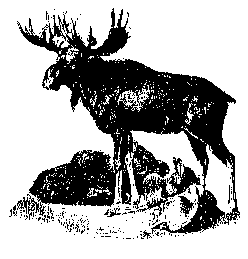
GOAL 2 To familiarize students with the range and
habitat of moose.
Activities:
A. Discuss the worldwide range of
moose.
a. Ask students where in the world
they would expect to find moose.
b. Show students on a world map, US map and
Alaska map where moose are found.
c. Have students make their own maps of the
local area to and indicate where moose are most commonly
found.
B. Discuss moose habitat.
a. What kind of a place do moose like
to live in and why?
-
include food, water, security, other
inhabitants.
b. Take a field trip:
-
what signs of moose can you find?
what other animals?
-
collect different types of moose
food: tree bark, willow shoots, sedge and leaves
c. Have students describe what would be
ideal moose habitat. (oral or written)
d. Make a scrapbook of moose in their
natural environment noting the types of plants they eat and the
different animals that are around them.
e. Discuss what effect changes in habitat
might have on the health of moose or on the moose population.
Does the abundance of moose change each year in the same area?
Speculate on reasons for this.
C. Discuss conflict between moose and other
creatures.
a. Have students list what conflicts a
moose might encounter
-
include, predators, loss of habit,
encounters between moose/people/vehicles, other
dangers
-
give local examples, examples from
newspaper, etc.
b. Have students suggest solutions to each
of these conflicts.
c. Interview local hunters about the
abundance or lack of moose in certain areas. How does the
hunter explain this? What solution would he/she suggest? Have
students prepare a table to reflect local opinions.
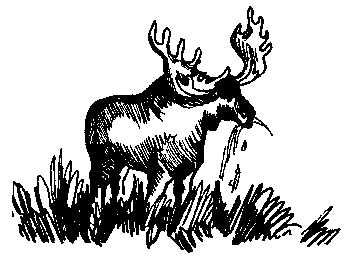
GOAL 3: To have students become aware of the
importance of moose to both the traditional and modern Alaskan way of
life.
Activities:
A. Learn about traditional Athabascan
values in relation to moose: sharing, non-wasting, respect,
etc.
a. Invite elders to come to class to
talk about moose. Ask about the first moose they ever saw,
their first hunt, how people used to treat moose and other
animals and why.
b. Read some Athabascan stories about
moose.
c. Discuss why moose was such an important
animal.
d. Go on an actual moose hunt with elders
and observe how they treat the moose and the
environment.
B. Compare traditional and modern hunting
techniques.
a. Discuss different types of weapons
used over the years. Speculate on their efficiency. How does
the type of weapon influence hunting technique?
b. Read about traditional moose hunting and
compare to modern day hunting.
c. Use a hunting story for
sequencing.
d. Have students relate their personal
hunting experiences.
e. Prepare a list of what to take on an
imaginary moose hunt.
f. Make a "Who Got Their Moose" graph.
C. Compare the traditional and present day uses
of moose.
a. Discuss and list what uses
traditional Athabascans had for moose. Stress the use of all
the different parts and how nothing was wasted.
b. How do people use moose
nowadays?
-
list uses of moose (see sample list
on following page)
-
make a chart of students' favorite
ways of eating moose
-
gather favorite moose recipes and
make a book
c. Do some "Moose Math":
-
compare pounds of meat per animal:
moose & cow
-
compare cost of moose meat to beef
(consider cost of the hunt vs going to the store,
etc.)
-
measure out skin-sewing patterns and
calculate how much moose skin is needed for various
items.
-
calculate how many pairs of mittens
can you get from one moose skin?
-
calculate cost of tanned moose skin
per square inch
D. Learn about preserving the meat.
a. Discuss how moose meat is preserved
in both modern and traditional ways. Which old ways are still
used? Make a chart to show this.
d. Experiment with different ways of making
moose jerky:
-
vary size of pieces, temperature,
amount of air, use of smoke or salt.
-
keep track of variables and observe
results carefully.
-
illustrate with graph or
chart.
- use
different flavorings. Make a chart to illustrate class
preferences.
e. Take part in an actual moose butchering
in the field and/or visit a butcher shop where meat is cut up
for freezing. Describe.
Some "Uses of Mooses"
|
Meat for Food:
|
legs, ribs, back, brisket
-
roast, steak, stew, soup dry meat
(jerky)
head -
moose head soup, boiled moose nose,
tongue
|
|
Brains:
|
for tanning
|
|
Hide:
|
covering for boat
tanned for clothing
babiche for sleds, snowshoe lacing fur
from ears to make mittens
|
|
Sinew:
|
made into thread for sewing
|
|
Bones:
|
shoulder bone to call moose
leg bone for scraper
|
|
Feet:
|
foot bone for doll or hair
ornament
hooves for jewelry
|
|
Horns:
|
handles for knives
|
Reference: Make Prayers to the Raven by
Richard Nelson lists many other traditional uses.
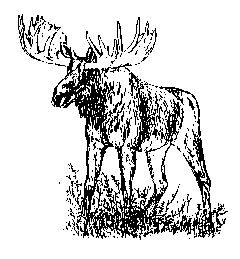
APPENDIX

Let's Learn about MOOSE
with Judy Kuhn, K-1 McGrath
School
Judy has many exciting activities for her class
when they are learning about MOOSE. She always takes lots of pictures
so last fall we made copies of some of them to include in the MOOSE
UNIT.
Here are some of the things she did with her
students. Pictures and instructions for some of them are on the
following pages.
Make a large poster of a moose and label his
parts.
Use hands and feet to make individual posters of
the mooses head.
Make a moose marionette.
Get ready for a moose hunt.
- Make a moose call with tin can and
string or with sticks.
- Make binoculars with empty toilet paper rolls.
Make a book about moose.
Make charts and graphs for the wall:
-
ways people use moose
- who got a
moose and who didn't
- favorite
ways of eating moose
Make up and illustrate moose riddles.
Have a parent come to class and bring a big set of
moose horns.
Take a field trip to watch someone cutting up a
moose.
Making a Moose Head with Your Hands and
Feet!
Paint students hands and feet with brown poster
paint (Add a little dish soap to make it come off more easily.) Use a
foot for the face, and hands for horns. To make the cow moose use a
fist instead of the whole hand.
Add eyes and nostrils.
Making a Moose Marionette
Instructions from Judy Kuhn, McGrath
School
Cut body, head and horns out of heavy cardboard.
Paint or color them. (See pattern on next page. It has been reduced
to 78% of original so you many want to enlarge it.)
Attach horns by inserting into the slot on the
head. Attach the head to the body with a strip of cloth.
Make legs out of long strips of fuzzy cloth, with
pieces of willow for hooves.
Attach puppet to a willow stick with strings from
the center of his back and his head.
Then make Mr. Moose walk and dance or just jump up
and down!
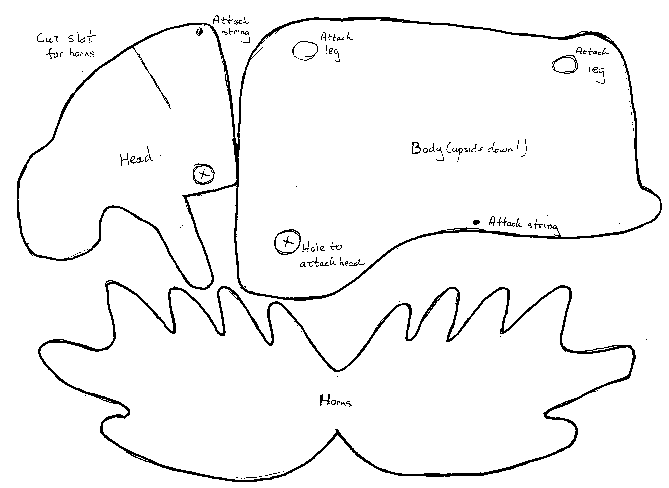
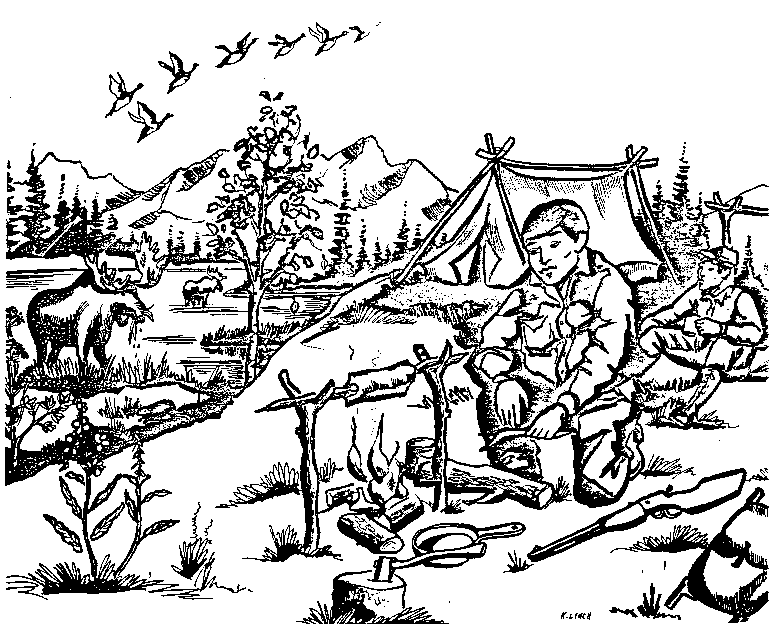
Handbook
for Culturally Responsive Science Curriculum by Sidney Stephens
Excerpt: "The information and insights contained in this document will be
of interest to anyone involved in bringing local knowledge to bear in school
curriculum. Drawing upon the efforts of many people over a period of several
years, Sidney Stephens has managed to distill and synthesize the critical ingredients
for making the teaching of science relevant and meaningful in culturally adaptable
ways." |